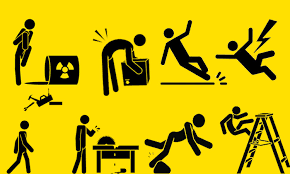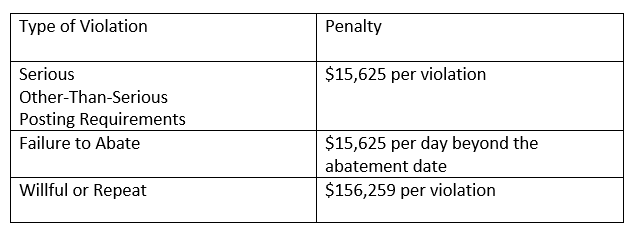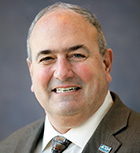
While you are making 2023 New Year Resolutions, please resolve to record work related injuries timely and appropriately on the OSHA logs. If you are an employer with more than 10 employees and are otherwise required to keep a record of serious work-related injuries and illnesses, remember to prepare the OSHA record keeping documents for posting and entry into OSHA’s Injury Tracking Application (ITA) system. As a reminder, you do not have to record minor injuries requiring first aid only. Make sure you are reporting any worker fatality within 8 hours and any amputation, loss of an eye, or hospitalization of a worker within 24 hours.
All records must be maintained at the worksite for at least five years. Each February through April, employers must post a summary of the injuries and illnesses recorded the previous year. Also, if requested, copies of the records must be provided to current and former employees, or their representatives. The reporting deadline is March 2, 2023 for occupational injury and illness summary reports for the 2022 reporting year. In fact, per current OSHA requirements, the ITA reporting deadline is March 2 every year for the previous calendar year’s 300A data.
Bugbee and Conkle also wanted to remind you that OSHA published a proposed rule, Improve Tracking of Workplace Injuries and Illnesses, on March 30, 2022 that will require:
- Establishments with 20 or more employees, in certain high-hazard industries, continue to electronically submit Form 300A Annual Summary information once a year to OSHA.
- Establishments with 100 or more employees in the highest-hazard industries to submit Form 300 Log and Form 301 Incident Report information once a year to OSHA. These establishments would continue to be required to electronically submit information from their Form 300A Annual Summary.
In addition, under the proposal, establishments with 250 or more employees, not in designated high-hazard industries, would no longer be required to electronically submit recordkeeping information to OSHA.
The proposal was based on OSHA’s preliminary determination that the electronic submission of establishment-specific and case-specific information from the Forms 300 and 301 will improve workplace safety and health by:
- Allowing OSHA to use its resources more effectively by better enabling the Agency to identify workplaces where workers are at greatest risk from specific hazards, and to target its compliance assistance and enforcement efforts accordingly;
- Improving the ability of employers to compare their own injury and illness data on hazards with the data from similar establishments in the same industry;
- Improving the ability of stakeholders to make more informed decisions using recent establishment-specific, case-specific, injury/illness information; and
- Improving research on occupational safety and health.
The comment period for the proposed rule has closed. If interested, read the proposed rule and the comments submitted by members of the public including workers and worker groups, affected industries, and other interested parties. In addition, you may examine all supporting materials for the proposed rule on the OSHA website. The next step in this rulemaking project will be development of the final rule.
Questions regarding recordkeeping should be sent to Bugbee and Conkle partner Carl Habekost at [email protected] for review or discussion.
OSHA Penalties Increase Effective January 17, 2023

OSHA increased the maximum penalty levels for 2023 effective starting January 17, 2023.
Congress passed the Federal Civil Penalties Inflation Adjustment Act Improvements Act in 2015 which requires agencies, including OSHA, to adjust the level of civil monetary penalties annually for inflation. The increases are to go in effect no later than January 15th of each year. However, January 15, 2023 was a Sunday and January 16, 2023 was a federal holiday. Therefore, the penalty increases became effective on January 17, 2023.
Please contact a member of our L&E Section for information or assistance in compliance with OSHA regulations to avoid OSHA citations and penalties.
Personal Protective Equipment Citation Requires Proof of Industry Custom or Actual Knowledge
The courts have held that for OSHA to prove a violation of a general or performance standard (such as a PPE regulation in 1910.132(a)), OSHA must show that the employer either failed to follow industry practice or that it had knowledge that the conduct was a violation of the standard. The Court of Appeals for the 11th Circuit last year reaffirmed this requirement in C&W Facility Services (11th Cir. 1/13/2022) and further clarified what is meant by “actual knowledge of the violation.” The language of 1910.132(a) requires that employers must provide personal protective equipment “wherever it is necessary by reason of hazards.” The employer, C&W Facility, was cited by OSHA after an employee who was pressure washing a boat dock fell into the water and drowned. The employee was not wearing an type of personal flotation device. OSHA found that a personal flotation device was required by the language of 1910.132(a) and issued a citation, accordingly.
The employer filed a Notice of Contest to OSHA’s citation bringing the issue before an Administrative Law Judge (ALJ) for adjudication. The ALJ held that OSHA only had to show the employer “was aware of the conditions that made the boat dock hazardous.” The ALJ relied upon a 10th Circuit Court of Appeals case in Jake’s Fireworks which held that OSHA only needed to show that the employer knew of the physical conditions present. The ALJ found that OSHA was not required to show the employer knew that those conditions rendered the job so hazardous that PPE was required by 1910.132(a).
On the employer’s appeal, the Court of Appeals said the ALJ failed to utilize the correct test. The Court of Appeals stated OSHA was required to establish evidence of the employer’s “specific, confirmed knowledge regarding hazards warranting a PPE requirement.” The Court of Appeals stated that actual knowledge means the employer had both actual knowledge of the hazard and had actual knowledge that the hazard requires the use of personal protective equipment.”
Please contact a member of our L&E Section with questions or concerns regarding OSHA regulations. We provide training and assist with the development of policies and procedures in OSHA matters.
Pushing the Profession Forward: The Role of the Newest Generation
By Don Elswick

As the workplace, the workforce, and work itself change, the occupational and environmental health and safety field must expand its focus. It’s crucial to ensure the health and well-being of a diverse workforce and to understand and mitigate safety issues in light of new work arrangements. We must forecast future trends, prepare for innovations in an ever-changing world, and always focus on long-term success.
The keys to moving forward largely rests with the use of technology, the engagement of workers, and emerging professionals. Despite the complexity and sophistication of our work – including inspections and investigations – advanced technologies aren’t always available, and the resources necessary to replace aging or obsolete equipment are inconsistent.
Thankfully, key technologies have emerged to offer better hazard management and mitigation. Among the many advancements are:
- Wearable devices for heat stress prevention;
- Infectious disease modeling and aerosol tracing technology to optimize heating, ventilating, and air conditioning systems for safety and sustainability; and
- Online training and artificial intelligence to deploy, monitor and manage ergonomics.
Maximizing the impact of these new technologies requires an engaged workforce. OEHS professionals must use available data and evidence to demonstrate the worthwhile nature of the profession. This will aid in developing a robust future workforce, building necessary partnerships, and gaining support and resources to deliver programs.
OEHS professionals must also strongly push for uniformity in data collection so their efforts can inform intervention practices effectively and efficiently across all sectors and all workers. By engaging workers and offering real-world solutions through consistent data, the OEHS profession can provide the workforce with a consensus on best practices to prevent serious injuries and fatalities.
As the workforce ages, leaders must provide accessible leadership training opportunities to support emerging OEHS professionals. Active participation in professional organizations creates opportunities for networking and mentorship.
The profession’s future will also be defined by the standardization of qualifications and a clear definition of responsibilities. Organizations such as the Board of Certified Safety Professionals and the Board for Global EHS Credentialing are continuously working on these standards, updating as needed to ensure technology and engagement are a focus of the certification process.
These are not new ideas. In fact, the late William (Bill) Weems, former director of Alabama Safe State Program, once provided sage insight into the ideas of technology, engagement, and emerging professionals. His advice was to find and pursue what excites and fulfills you, to pursue lifelong learning, and to be empathetic and honest with employees to build a relationship of trust, committing even in times of disagreement to decisions based on evidence-based science.
With those concepts driving the future of the workforce and the technologies it develops, the outlook of the OEHS profession is bright and full of career opportunities with great fulfillment.
Don Elswick, CIH, CSP, CHMM, CIT, is an EHS solutions specialist for ELSMART Associates LLC, and previously was the executive director of the University of Alabama Safe State Program. He’s chair of the American Conference of Governmental Industrial Hygienists and serves on the state of Alabama’s Technical Advisory Committee on Science, Technology, Engineering, and Math.

